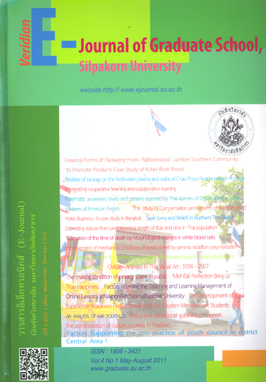ระดับและรูปแบบความตระหนักเชิงวัจนปฏิบัติศาสตร์ของผู้เรียนภาษาอังกฤษชาวไทย และเจ้าของภาษาชาวอเมริกัน
Main Article Content
บทคัดย่อ
บทคัดย่อ
งานวิจัยนี้มีวัตถุประสงค์เพื่อศึกษาเปรียบเทียบระดับความตระหนักเชิงวัจนปฏิบัติศาสตร์ ระหว่างผู้เรียนภาษาอังกฤษชาวไทยกลุ่มเก่ง กลุ่มอ่อนและเจ้าของภาษาชาวอเมริกัน และเพื่อศึกษาหา รูปแบบความตระหนักเชิงวัจนปฏิบัติศาสตร์ของผู้เรียนภาษาอังกฤษชาวไทย การศึกษาระดับความตระหนัก เชิงวัจนปฏิบัติศาสตร์ทำโดยให้กลุ่มตัวอย่างทั้งสามกลุ่มรวม 90 คนรายงานความเหมาะสมของสำนวนวัจ นกรรมการขอร้องและการให้คำแนะนำในมาตรวัดระดับ จากนั้นกลุ่มตัวอย่างผู้เรียนชาวไทย 12 คนได้ถูกสุ่ม มาจากกลุ่มเก่งและกลุ่มอ่อนเพื่อทำแบบวิเคราะห์สำนวนวัจนกรรม เพื่อหารูปแบบความตระหนักเชิงวัจน ปฏิบัติศาสตร์ของผู้เรียนชาวไทย ผลการศึกษาพบว่ากลุ่มตัวอย่างผู้เรียนชาวไทยทั้งสองกลุ่มรายงานระดับ ความตระหนักในระดับที่ใกล้เคียงกัน แต่มีความแตกต่างอย่างมีนัยสำคัญทางสถิติกับกลุ่มตัวอย่างชาว อเมริกัน ผู้เรียนชาวไทยทั้งสองกลุ่มมีรูปแบบร่วมทางความตระหนักเชิงวัจนปฏิบัติศาสตร์ที่คล้ายกัน โดย กลุ่มตัวอย่างแสดงความตระหนักครอบคลุมทั้งปัจจัยทางสังคมและทางภาษาศาสตร์ ข้อแตกต่างระหว่าง รูปแบบความตระหนักของผู้เรียนชาวไทยทั้งสองกลุ่มคือ ความแตกต่างด้านความรู้เรื่องสำนวนตามธรรม เนียมปฏิบัติและการรับรู้ปัจจัยด้านอำนาจ สาเหตุหลักของความแตกต่างด้านระดับความตระหนักเชิงวัจน ปฏิบัติศาสตร์ระหว่างผู้เรียนชาวไทยและกลุ่มตัวอย่างชาวอเมริกัน คือ ความไม่เข้าใจกลวิธีความสุภาพใน ภาษาอังกฤษของผู้เรียนชาวไทย และการรับรู้ปัจจัยทางสังคมที่แตกต่างกันระหว่างผู้เรียนชาวไทยและกลุ่ม ตัวอย่างชาวอเมริกัน
Abstract
The objective of this study is two-fold. Firstly, to compare levels of pragmatic awareness between Thai EFL learners of high- and low-English proficiency and Americans, and secondly, to examine patterns of pragmatic awareness reported by the two groups of Thai learners. A total of 90 subjects, 30 for each group, were asked to judge the appropriateness level of the speech act of request and suggestion in a rating scale. Then, 12 Thai learners from the high- and low-English proficiency groups were chosen at random to attend the patterns of pragmatic awareness test. Results reveal that, overall, the two groups of Thai learners report similar levels of pragmatic awareness, which are different from those of the Americans in terms of statistical significance. Results on patterns of pragmatic awareness show a correspondence between patterns reported by the two groups of Thai learners. The subjects from both groups show their awareness of sociopragmatic and pragmalinguistic components. The differences in their awareness patterns are their recognition of conventional forms and their perception of relative power. Possible factors leading to the differences between Thai learners’ and the American’s levels of pragmatic awareness are the incomprehension of English politeness strategies of the Thai learners and the difference in sociopragmatic perception between the Thais and the Americans.

